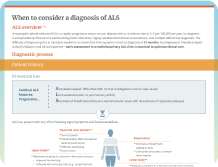
There’s always more to learn
Explore a comprehensive suite of resources that cover different topics about ALS. Whether you are a person living with ALS, a caregiver or healthcare professional, there’s always more to learn.
Professional education tools
Clinical resources
-
Videos: Role of multidisciplinary ALS/neuromuscular clinics in ALS management
Sit down with Dr. Geneviève Matte and Dr. Wendy Johnston as they discuss the importance of multidisciplinary ALS/neuromuscular clinics in shortening the time to diagnosis, best practices in delivering a diagnosis to a patient and clarify the clinics that patients can be referred to in Quebec.
-

Accelerate ALS diagnoses with Artificial Intelligence (AI)
Explore a new way to identify patients at risk of ALS with this AI-based program, Process for Progress. This program uses a clinical algorithm powered by AI to help patients achieve a faster diagnoses for timely access to care and a better quality of life.
ALSPathways podcast series: Professional edition
This series brings different ALS experts together to share practical insights on a variety of ALS-related topics in bite-sized episodes that can be streamed whenever and wherever you are:
Key challenges in the diagnosis of ALS
Many factors contribute to the current ALS diagnostic gap that exists in Canada. Dr. Lorne Zinman and Dr. Hanika Pinto discuss the challenges healthcare providers face, answer key questions and share practical tips around the identification and diagnosis of ALS, including key referral flags to look for in your practice.
Connecting ALS
In this episode, Jeremy sits down with Dr. Melinda Kavanaugh, Colleen O’Connell, Cathy Cummings and Marc Massé to talk about the challenges of receiving and delivering difficult news, such as a diagnosis, and the professional training needed to improve this experience for patients and their loved ones.
What other topics should we add?
Feel free to give us feedback on the ALSPathways podcast series or suggest a topic you’d like us to cover in the future.















